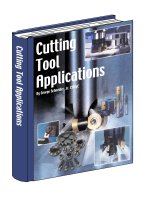Engineering Mechanics - Statics Episode 1 Part 6 ppsx
Bạn đang xem bản rút gọn của tài liệu. Xem và tải ngay bản đầy đủ của tài liệu tại đây (485.06 KB, 40 trang )
Engineering Mechanics - Statics Chapter 3
pp p
rings at C and D.
Given:
δ
1.5 ft=
k 40
lb
ft
=
d 2ft=
F 60 lb=
Solution:
Initial guesses:
F
s
1lb= T 1lb= y 1ft=
Given
F
y
2d
T− 0=
d
2
y
2
⎛
⎜
⎝
⎞
⎟
⎠
2
−
d
TF
s
− 0= F
s
kd d
2
y
2
⎛
⎜
⎝
⎞
⎟
⎠
2
−−
δ
+
⎡
⎢
⎣
⎤
⎥
⎦
=
F
s
T
y
⎛
⎜
⎜
⎜
⎝
⎞
⎟
⎟
⎟
⎠
Find F
s
T, y,
()
=
F
s
T
⎛
⎜
⎝
⎞
⎟
⎠
76.92
97.55
⎛
⎜
⎝
⎞
⎟
⎠
lb= y 2.46 ft=
Problem 3-69
Cord AB of length a is attached to the end B of a spring having an unstretched length b. The other
end of the spring is attached to a roller C so that the spring remains horizontal as it stretches. If a
weight W is suspended from B, determine the angle
θ
of cord AB for equilibrium.
201
© 2007 R. C. Hibbeler. Published by Pearson Education, Inc., Upper Saddle River, NJ. All rights reserved.
This material is protected under all copyright laws as they currently exist. No portion of this material may
be reproduced, in any form or by any means, without permission in writing from the publisher.
Engineering Mechanics - Statics Chapter 3
Given:
a 5ft=
b 5ft=
k 10
lb
ft
=
W 10 lb=
Solution:
Initial Guesses
F
BA
1lb=
F
sp
1lb=
θ
30 deg=
Given
F
sp
F
BA
cos
θ
()
− 0=
F
BA
sin
θ
()
W− 0=
F
sp
ka acos
θ
()
−
()
=
F
sp
F
BA
θ
⎛
⎜
⎜
⎜
⎝
⎞
⎟
⎟
⎟
⎠
Find F
sp
F
BA
,
θ
,
()
=
F
sp
F
BA
⎛
⎜
⎝
⎞
⎟
⎠
11.82
15.49
⎛
⎜
⎝
⎞
⎟
⎠
lb=
θ
40.22 deg=
Problem 3-70
The uniform crate of mass M is suspended by using a cord of length l that is attached to the sides of
the crate and passes over the small pulley at O. If the cord can be attached at either points A and B, or
C and D, determine which attachment produces the least amount of tension in the cord and specify
the cord tension in this case.
202
© 2007 R. C. Hibbeler. Published by Pearson Education, Inc., Upper Saddle River, NJ. All rights reserved.
This material is protected under all copyright laws as they currently exist. No portion of this material may
be reproduced, in any form or by any means, without permission in writing from the publisher.
Engineering Mechanics - Statics Chapter 3
Given:
M 50 kg=
g 9.81
m
s
2
=
a 0.6 m=
b 1.5 m=
l 2m=
c
a
2
=
d
b
2
=
Solution:
Case 1 Attached at A and B Guess
T 1N=
Given Mg
l
2
⎛
⎜
⎝
⎞
⎟
⎠
2
d
2
−
l
2
⎡
⎢
⎢
⎢
⎢
⎣
⎤
⎥
⎥
⎥
⎥
⎦
2T− 0= T
1
Find T()= T
1
370.78 N=
Case 2 Attached at C and D Guess
T 1N=
Given Mg
l
2
⎛
⎜
⎝
⎞
⎟
⎠
2
c
2
−
l
2
⎡
⎢
⎢
⎢
⎢
⎣
⎤
⎥
⎥
⎥
⎥
⎦
2T− 0= T
2
Find T()= T
2
257.09 N=
Choose the arrangement that
gives the smallest tension.
T min T
1
T
2
,
()
= T 257.09 N=
Problem 3-71
The man attempts to pull the log at C by using the three ropes. Determines the direction
θ
in which he should
p
ull on his ro
p
e with a force
P
, so that he exerts a maximum
203
© 2007 R. C. Hibbeler. Published by Pearson Education, Inc., Upper Saddle River, NJ. All rights reserved.
This material is protected under all copyright laws as they currently exist. No portion of this material may
be reproduced, in any form or by any means, without permission in writing from the publisher.
Engineering Mechanics - Statics Chapter 3
pp
force on the log. What is the force on the log for this case ? Also, determine the direction
in which he should pull in order to maximize the force in the rope attached to B.What is this
maximum force?
Given:
P 80 lb=
φ
150 deg=
Solution:
+
→
F
AB
P cos
θ
()
+ F
AC
sin
φ
90 deg−
()
− 0=
Σ
F
x
= 0;
+
↑
Σ
F
y
= 0;
P sin
θ
()
F
AC
cos
φ
90 deg−
()
− 0=
F
AC
P sin
θ
()
cos
φ
90deg−
()
=
In order to maximize FAC we choose
sin
θ
()
1.=
Thus
θ
90 deg= F
AC
P sin
θ
()
cos
φ
90deg−
()
= F
AC
160.00 lb=
Now let's find the force in the rope AB.
F
AB
P− cos
θ
()
F
AC
sin
φ
90 deg−
()
+=
F
AB
P− cos
θ
()
P sin
θ
()
sin
φ
90 deg−
()
cos
φ
90 deg−
()
+=
F
AB
P
sin
θ
()
sin
φ
90 deg−
()
cos
θ
()
cos
φ
90 deg−
()
−
cos
φ
90 deg−
()
= P−
cos
θφ
+ 90deg−
()
cos
φ
90 deg−
()
=
204
© 2007 R. C. Hibbeler. Published by Pearson Education, Inc., Upper Saddle River, NJ. All rights reserved.
This material is protected under all copyright laws as they currently exist. No portion of this material may
be reproduced, in any form or by any means, without permission in writing from the publisher.
Engineering Mechanics - Statics Chapter 3
In order to maximize the force we set
cos
θφ
+ 90 deg−
(
)
1−=
θφ
+ 90 deg− 180 deg=
θ
270 deg
φ
−=
θ
120.00 deg=
F
AB
P−
cos
θφ
+ 90 deg−
()
cos
φ
90 deg−
()
= F
AB
160.00 lb=
Problem 3-72
The "scale" consists of a known weight W which is suspended at A from a cord of total length L.
Determine the weight w at B if A is at a distance y for equilibrium. Neglect the sizes and weights of
the pulleys.
Solution:
+
↑
Σ
F
y
= 0;
2W sin
θ
()
w− 0=
Geometry
h
Ly−
2
⎛
⎜
⎝
⎞
⎟
⎠
2
d
2
⎛
⎜
⎝
⎞
⎟
⎠
2
−=
1
2
Ly−()
2
d
2
−=
205
© 2007 R. C. Hibbeler. Published by Pearson Education, Inc., Upper Saddle River, NJ. All rights reserved.
This material is protected under all copyright laws as they currently exist. No portion of this material may
be reproduced, in any form or by any means, without permission in writing from the publisher.
Engineering Mechanics - Statics Chapter 3
w 2W
1
2
Ly−()
2
d
2
+
Ly−
2
⎡
⎢
⎢
⎢
⎣
⎤
⎥
⎥
⎥
⎦
= w
2W
Ly−
Ly−()
2
d
2
−=
Problem 3-73
Determine the maximum weight W that can be supported in the
position shown if each cable AC and AB can support a maximum
tension of
F
before it fails.
Given:
θ
30 deg=
F 600 lb=
c 12=
d 5=
Solution:
Initial Guesses
F
AB
F= F
AC
F= WF=
Case 1 Assume that cable AC reaches maximum tension
Given F
AC
sin
θ
()
d
c
2
d
2
+
F
AB
− 0=
F
AC
cos
θ
()
c
c
2
d
2
+
F
AB
+ W− 0=
W
1
F
AB1
⎛
⎜
⎝
⎞
⎟
⎠
Find WF
AB
,
()
=
W
1
F
AB1
⎛
⎜
⎝
⎞
⎟
⎠
1239.62
780.00
⎛
⎜
⎝
⎞
⎟
⎠
lb=
Case 2 Assume that cable AB reaches maximum tension
206
© 2007 R. C. Hibbeler. Published by Pearson Education, Inc., Upper Saddle River, NJ. All rights reserved.
This material is protected under all copyright laws as they currently exist. No portion of this material may
be reproduced, in any form or by any means, without permission in writing from the publisher.
Engineering Mechanics - Statics Chapter 3
Given F
AC
sin
θ
()
d
c
2
d
2
+
F
AB
− 0=
F
AC
cos
θ
()
c
c
2
d
2
+
F
AB
+ W− 0=
W
2
F
AC2
⎛
⎜
⎝
⎞
⎟
⎠
Find WF
AC
,
()
=
W
2
F
AC2
⎛
⎜
⎝
⎞
⎟
⎠
953.55
461.54
⎛
⎜
⎝
⎞
⎟
⎠
lb=
W min W
1
W
2
,
()
= W 953.6 lb=
Problem 3-74
If the spring on rope OB has been stretched a distance
δ
. and fixed in place as shown, determine the
tension developed in each of the other three ropes in order to hold the weight W in equilibrium. Rope
OD lies in the x-y plane.
Given:
a 2ft=
b 4ft=
c 3ft=
d 4ft=
e 4ft=
f 4ft=
x
B
2− ft=
y
B
3− ft=
z
B
3ft=
θ
30 deg=
k 20
lb
in
=
δ
2in=
W 225 lb=
207
© 2007 R. C. Hibbeler. Published by Pearson Education, Inc., Upper Saddle River, NJ. All rights reserved.
This material is protected under all copyright laws as they currently exist. No portion of this material may
be reproduced, in any form or by any means, without permission in writing from the publisher.
Engineering Mechanics - Statics Chapter 3
Solution:
Initial Guesses
F
OA
10 lb= F
OC
10 lb= F
OD
10 lb=
Given
c
a
2
b
2
+ c
2
+
F
OA
k
δ
x
B
x
B
2
y
B
2
+ z
B
2
+
+
d−
d
2
e
2
+ f
2
+
F
OC
+ F
OD
sin
θ
()
+ 0=
b−
a
2
b
2
+ c
2
+
F
OA
k
δ
y
B
x
B
2
y
B
2
+ z
B
2
+
+
f
d
2
e
2
+ f
2
+
F
OC
+ F
OD
cos
θ
()
+ 0=
a
a
2
b
2
+ c
2
+
F
OA
k
δ
z
B
x
B
2
y
B
2
+ z
B
2
+
+
e
d
2
e
2
+ f
2
+
F
OC
+ W− 0=
F
OA
F
OC
F
OD
⎛
⎜
⎜
⎜
⎝
⎞
⎟
⎟
⎟
⎠
Find F
OA
F
OC
, F
OD
,
()
=
F
OA
F
OC
F
OD
⎛
⎜
⎜
⎜
⎝
⎞
⎟
⎟
⎟
⎠
201.6
215.7
58.6
⎛
⎜
⎜
⎝
⎞
⎟
⎟
⎠
lb=
Problem 3-75
The joint of a space frame is subjected to four
member forces. Member OA lies in the x - y plane
and member OB lies in the y - z plane. Determine the
forces acting in each of the members required for
equilibrium of the joint.
Given:
F
4
200 lb=
θ
40 deg=
φ
45 deg=
Solution:
The initial guesses
:
F
1
200 lb= F
2
200 lb= F
3
200 lb=
208
© 2007 R. C. Hibbeler. Published by Pearson Education, Inc., Upper Saddle River, NJ. All rights reserved.
This material is protected under all copyright laws as they currently exist. No portion of this material may
be reproduced, in any form or by any means, without permission in writing from the publisher.
Engineering Mechanics - Statics Chapter 3
Given
Σ
F
y
= 0;
F
3
F
1
cos
φ
()
+ F
2
cos
θ
()
− 0=
Σ
F
x
= 0;
F
1
− sin
φ
()
0=
Σ
F
z
= 0;
F
2
sin
θ
()
F
4
− 0=
F
1
F
2
F
3
⎛
⎜
⎜
⎜
⎝
⎞
⎟
⎟
⎟
⎠
Find F
1
F
2
, F
3
,
()
=
F
1
F
2
F
3
⎛
⎜
⎜
⎜
⎝
⎞
⎟
⎟
⎟
⎠
0
311.1
238.4
⎛
⎜
⎜
⎝
⎞
⎟
⎟
⎠
lb=
209
© 2007 R. C. Hibbeler. Published by Pearson Education, Inc., Upper Saddle River, NJ. All rights reserved.
This material is protected under all copyright laws as they currently exist. No portion of this material may
be reproduced, in any form or by any means, without permission in writing from the publisher.
Engineering Mechanics - Statics Chapter 4
Problem 4-1
If
A
,
B
, and
D
are given vectors, prove the distributive law for the vector cross product, i.e.,
ABD+
()
× AB×
()
AD×
()
+=
.
Solution:
Consider the three vectors; with
A
vertical.
Note triangle obd is perpendicular to
A
.
od ABD+
()
×= A BD+
()
sin
θ
3
()
=
ob AB×= A B sin
θ
1
()
=
bd AD×= A B sin
θ
2
()
=
Also, these three cross products all lie in the plane
obd since they are all perpendicular to A. As noted
the magnitude of each cross product is
proportional to the length of each side of the
triangle.
The three vector cross - products also form a
closed triangle o'b'd' which is similar to triangle obd.
Thus from the figure,
ABD+
()
× AB× AD×+=
(QED)
Note also
,
A A
x
i A
y
j+ A
z
k+=
B B
x
i B
y
j+ B
z
K+=
D D
x
i D
y
j+ D
z
k+=
ABD+
()
×
i
A
x
B
x
D
x
+
j
A
y
B
y
D
y
+
k
A
z
B
z
D
z
+
⎛
⎜
⎜
⎜
⎝
⎞
⎟
⎟
⎟
⎠
=
=
A
y
B
z
D
z
+
()
A
z
B
y
D
y
+
()
−
⎡
⎣
⎤
⎦
i A
x
B
z
D
z
+
()
A
z
B
x
D
x
+
()
−
⎡
⎣
⎤
⎦
j− A
x
B
y
D
y
+
()
A
y
B
x
D
x
−
()
−
⎡
⎣
⎤
⎦
k+
=
A
y
B
z
A
z
B
y
−
()
i A
x
B
z
A
z
B
x
−
()
j− A
x
B
y
A
y
B
x
−
()
k+
⎡
⎣
⎤
⎦
A
y
D
z
A
z
D
y
−
()
i A
x
D
z
A
z
D
x
−
()
j− A
x
D
y
A
y
D
x
−
()
k+
⎡
⎣
⎤
⎦
+
210
© 2007 R. C. Hibbeler. Published by Pearson Education, Inc., Upper Saddle River, NJ. All rights reserved.
This material is protected under all copyright laws as they currently exist. No portion of this material may
be reproduced, in any form or by any means, without permission in writing from the publisher.
Engineering Mechanics - Statics Chapter 4
=
i
A
x
B
x
j
A
y
B
y
k
A
z
B
z
⎛
⎜
⎜
⎜
⎝
⎞
⎟
⎟
⎟
⎠
i
A
x
D
x
j
A
y
D
y
k
A
z
D
z
⎛
⎜
⎜
⎜
⎝
⎞
⎟
⎟
⎟
⎠
+
=
AB×
()
AD×
()
+
(QED)
Problem 4-2
Prove the triple scalar product identity
AB C×
()
⋅ AB×
()
C⋅=
.
Solution:
As shown in the figure
Area B Csin
θ
()()
= BC×=
Thus,
Volume of parallelopiped is
BC× h
But,
h Au
BC×
⋅= A
BC×
BC×
⎛
⎜
⎝
⎞
⎟
⎠
⋅=
Thus,
Volume AB C×
()
⋅=
Since
AB× C⋅
represents this same volume then
AB C×
()
⋅ AB×
()
C⋅=
(QED)
Also,
LHS AB C×
()
⋅=
=
A
x
i A
y
j+ A
z
k+
()
i
B
x
C
x
j
B
y
C
y
k
B
z
C
z
⎛
⎜
⎜
⎜
⎝
⎞
⎟
⎟
⎟
⎠
=
A
x
B
y
C
z
B
z
C
y
−
()
A
y
B
x
C
z
B
z
C
x
−
()
− A
z
B
x
C
y
B
y
C
x
−
()
+
=
A
x
B
y
C
z
A
x
B
z
C
y
− A
y
B
x
C
z
− A
y
B
z
C
x
+ A
z
B
x
C
y
+ A
z
B
y
C
x
−
RHS AB×
()
C⋅=
211
© 2007 R. C. Hibbeler. Published by Pearson Education, Inc., Upper Saddle River, NJ. All rights reserved.
This material is protected under all copyright laws as they currently exist. No portion of this material may
be reproduced, in any form or by any means, without permission in writing from the publisher.
Engineering Mechanics - Statics Chapter 4
=
i
A
x
B
x
j
A
y
B
y
k
A
z
B
z
⎛
⎜
⎜
⎜
⎝
⎞
⎟
⎟
⎟
⎠
C
x
i C
y
j+ C
z
k+
()
=
C
x
A
y
B
z
A
z
B
y
−
()
C
y
A
x
B
z
A
z
B
x
−
()
− C
z
A
x
B
y
A
y
B
x
−
()
+
=
A
x
B
y
C
z
A
x
B
z
C
y
− A
y
B
x
C
z
− A
y
B
z
C
x
+ A
z
B
x
C
y
+ A
z
B
y
C
x
−
Thus,
LHS RHS=
AB⋅ C× AB× C⋅=
(QED)
Problem 4-3
Given the three nonzero vectors
A
,
B
, and
C
, show that if
AB C×
()
⋅ 0=
, the three vectors
must lie in the same plane.
Solution:
Consider,
AB C×
()
⋅ A BC× cos
θ
()
=
=
A cos
θ
()()
BC×
=
h BC×
= BC
h sin
φ
()
= volume of parallelepiped.
If
AB C×
()
⋅ 0=
, then the volume equals zero, so that
A
,
B
, and
C
are coplanar.
Problem 4-4
Determine the magnitude and directional sense of the resultant moment of the forces at A and B
about point O.
Given:
F
1
40 lb=
F
2
60 lb=
212
© 2007 R. C. Hibbeler. Published by Pearson Education, Inc., Upper Saddle River, NJ. All rights reserved.
This material is protected under all copyright laws as they currently exist. No portion of this material may
be reproduced, in any form or by any means, without permission in writing from the publisher.
Engineering Mechanics - Statics Chapter 4
θ
1
30 deg=
θ
2
45 deg=
a 5in=
b 13 in=
c 3in=
d 6in=
e 3in=
f 6in=
Solution:
M
RO
=
Σ
M
O
;
M
RO
F
1
cos
θ
2
()
eF
1
sin
θ
2
()
f− F
2
cos
θ
1
()
b
2
a
2
−− F
2
sin
θ
1
()
a−=
M
RO
858− lb in⋅= M
RO
858lb in⋅=
Problem 4-5
Determine the magnitude and directional sense of the
resultant moment of the forces at A and B about
point P.
Units Used:
kip 1000 lb=
Given:
F
1
40 lb= b 13 in=
F
2
60 lb= c 3in=
θ
1
30 deg= d 6in=
θ
2
45 deg= e 3in=
a 5in= f 6in=
Solution:
M
RP
=
Σ
M
P
;
M
RP
F
1
cos
θ
2
()
ec+()F
1
sin
θ
2
()
df+()− F
2
cos
θ
1
()
b
2
a
2
− d+
()
−
F
2
− sin
θ
1
()
ac−()+
=
213
© 2007 R. C. Hibbeler. Published by Pearson Education, Inc., Upper Saddle River, NJ. All rights reserved.
This material is protected under all copyright laws as they currently exist. No portion of this material may
be reproduced, in any form or by any means, without permission in writing from the publisher.
Engineering Mechanics - Statics Chapter 4
M
RP
1165− lb in⋅= M
RP
1.17 kip in⋅=
Problem 4-6
Determine the magnitude of the force
F
that
should be applied at the end of the lever such
that this force creates a clockwise moment M
about point O.
Given:
M 15 Nm=
φ
60 deg=
θ
30 deg=
a 50 mm=
b 300 mm=
Solution:
MFcos
θ
()
absin
φ
()
+
()
F sin
θ
()
bcos
φ
()()
−=
F
M
cos
θ
()
absin
φ
()
+
()
sin
θ
()
bcos
φ
()()
−
= F 77.6 N=
Problem 4-7
Determine the angle
θ
(0 <=
θ
<= 90 deg) so that the force
F
develops a clockwise moment M
about point O.
Given:
F 100 N=
φ
60 deg=
214
© 2007 R. C. Hibbeler. Published by Pearson Education, Inc., Upper Saddle River, NJ. All rights reserved.
This material is protected under all copyright laws as they currently exist. No portion of this material may
be reproduced, in any form or by any means, without permission in writing from the publisher.
Engineering Mechanics - Statics Chapter 4
M 20 N m⋅= a 50 mm=
θ
30 deg= b 300 mm=
Solution:
I
nitial Guess
θ
30 deg=
Given
MFcos
θ
()
absin
φ
()
+
()
F sin
θ
()
bcos
φ
()()
−=
θ
Find
θ
()
=
θ
28.6 deg=
Problem 4-8
Determine the magnitude and directional sense of the moment of the forces about point O.
Units Used:
kN 10
3
N=
Given:
F
B
260 N= e 2m=
a 4m= f 12=
b 3m= g 5=
c 5m=
θ
30 deg=
d 2m= F
A
400 N=
Solution:
M
o
F
A
sin
θ
()
dF
A
cos
θ
()
c+ F
B
f
f
2
g
2
+
ae+()+=
M
o
3.57 kN m⋅=
(positive means counterclockwise)
215
© 2007 R. C. Hibbeler. Published by Pearson Education, Inc., Upper Saddle River, NJ. All rights reserved.
This material is protected under all copyright laws as they currently exist. No portion of this material may
be reproduced, in any form or by any means, without permission in writing from the publisher.
Engineering Mechanics - Statics Chapter 4
Problem 4-9
Determine the magnitude and directional sense of the moment of the forces about point P.
Units Used:
kN 10
3
N=
Given:
F
B
260 N= e 2m=
a 4m= f 12=
b 3m= g 5=
c 5m=
θ
30 deg=
d 2m=
F
A
400 N=
Solution:
M
p
F
B
g
f
2
g
2
+
bF
B
f
f
2
g
2
+
e+ F
A
sin
θ
()
ad−()− F
A
cos
θ
()
bc+()+=
M
p
3.15 kN m⋅=
(positive means counterclockwise)
Problem 4-10
A force
F
is applied to the wrench. Determine the moment of this force about point O. Solve
the problem using both a scalar analysis and a vector analysis.
216
© 2007 R. C. Hibbeler. Published by Pearson Education, Inc., Upper Saddle River, NJ. All rights reserved.
This material is protected under all copyright laws as they currently exist. No portion of this material may
be reproduced, in any form or by any means, without permission in writing from the publisher.
Engineering Mechanics - Statics Chapter 4
Given:
F 40 N=
θ
20 deg=
a 30 mm=
b 200 mm=
Scalar Solution
M
O
F− cos
θ
()
bFsin
θ
()
a+=
M
O
7.11− Nm⋅= M
O
7.11 N m⋅=
Vector Solution
M
O
b
a
0
⎛
⎜
⎜
⎝
⎞
⎟
⎟
⎠
F− sin
θ
()
F− cos
θ
()
0
⎛
⎜
⎜
⎝
⎞
⎟
⎟
⎠
×= M
O
0
0
7.11−
⎛
⎜
⎜
⎝
⎞
⎟
⎟
⎠
Nm⋅= M
O
7.107 N m⋅=
Problem 4-11
Determine the magnitude and directional sense of the resultant moment of the forces about
point O.
Units Used:
kip 10
3
lb=
Given:
F
1
300 lb= e 10 ft=
F
2
250 lb= f 4=
a 6ft= g 3=
b 3ft=
θ
30 deg=
c 4ft=
φ
30 deg=
d 4ft=
217
© 2007 R. C. Hibbeler. Published by Pearson Education, Inc., Upper Saddle River, NJ. All rights reserved.
This material is protected under all copyright laws as they currently exist. No portion of this material may
be reproduced, in any form or by any means, without permission in writing from the publisher.
Engineering Mechanics - Statics Chapter 4
Solution:
M
o
F
2
f
f
2
g
2
+
esin
φ
()
F
2
g
f
2
g
2
+
ecos
φ
()
+ F
1
sin
θ
()
a+ F
1
cos
θ
()
b−=
M
o
2.42 kip ft⋅=
positive means clockwise
Problem 4-12
To correct a birth defect, the tibia of the leg is straightened using three wires that are attached
through holes made in the bone and then to an external brace that is worn by the patient.
Determine the moment of each wire force about joint A.
Given:
F
1
4N= d 0.15 m=
F
2
8N= e 20 mm=
F
3
6N= f 35 mm=
a 0.2 m= g 15 mm=
b 0.35 m=
θ
1
30 deg=
c 0.25 m=
θ
2
15 deg=
Solution: Positive means counterclockwise
M
A1
F
1
cos
θ
2
()
dF
1
sin
θ
2
()
e+= M
A1
0.6 N m⋅=
M
A2
F
2
cd+()= M
A2
3.2 N m⋅=
M
A3
F
3
cos
θ
1
()
bc+ d+()F
3
sin
θ
1
()
g−= M
A3
3.852 N m⋅=
Problem 4-13
To correct a birth defect, the tibia of the leg is straightened using three wires that are attached
through holes made in the bone and then to an external brace that is worn by the patient.
Determine the moment of each wire force about joint B.
Given:
F
1
4N= d 0.15 m=
218
© 2007 R. C. Hibbeler. Published by Pearson Education, Inc., Upper Saddle River, NJ. All rights reserved.
This material is protected under all copyright laws as they currently exist. No portion of this material may
be reproduced, in any form or by any means, without permission in writing from the publisher.
Engineering Mechanics - Statics Chapter 4
F
2
8N= e 20 mm=
F
3
6N= f 35 mm=
a 0.2 m= g 15 mm=
b 0.35 m=
θ
1
30 deg=
c 0.25 m=
θ
2
15 deg=
Solution:
Positive means clockwise
M
B1
F
1
cos
θ
2
()
ab+ c+()F
1
sin
θ
2
()
e−= M
B1
3.07 N m⋅=
M
B2
F
2
ab+()= M
B2
4.4 N m⋅=
M
B3
F
3
cos
θ
1
()
aF
3
sin
θ
1
()
g+= M
B3
1.084 N m⋅=
Problem 4-14
Determine the moment of each force about the bolt located at A.
Given:
F
B
40 lb= a 2.5 ft=
α
20 deg=
γ
30 deg=
F
C
50 lb= b 0.75 ft=
β
25 deg=
219
© 2007 R. C. Hibbeler. Published by Pearson Education, Inc., Upper Saddle River, NJ. All rights reserved.
This material is protected under all copyright laws as they currently exist. No portion of this material may
be reproduced, in any form or by any means, without permission in writing from the publisher.
Engineering Mechanics - Statics Chapter 4
Solution:
M
B
F
B
cos
β
()
a=
M
B
90.6 lb ft⋅=
M
C
F
C
cos
γ
()
ab+()=
M
C
141lb ft⋅=
Problem 4-15
Determine the resultant moment about the bolt located at A.
Given:
F
B
30 lb=
F
C
45 lb=
a 2.5 ft=
b 0.75 ft=
α
20 deg=
β
25 deg=
γ
30 deg=
Solution:
M
A
F
B
cos
β
()
aF
C
cos
γ
()
ab+()+= M
A
195lb ft⋅=
Problem 4-16
The elbow joint is flexed using the biceps brachii muscle, which remains essentially vertical as
the arm moves in the vertical plane. If this muscle is located a distance a from the pivot point
A on the humerus, determine the variation of the moment capacity about A if the constant
force developed by the muscle is F. Plot these results of M vs.
θ
for
60−
θ
≤ 80≤
.
220
© 2007 R. C. Hibbeler. Published by Pearson Education, Inc., Upper Saddle River, NJ. All rights reserved.
This material is protected under all copyright laws as they currently exist. No portion of this material may
be reproduced, in any form or by any means, without permission in writing from the publisher.
Engineering Mechanics - Statics Chapter 4
Units Used:
kN 10
3
N=
Given:
a 16 mm=
F 2.30 kN=
θ
60− 80 ()=
Solution:
M
A
θ
()
Fa( ) cos
θ
deg
()
=
50 0 50 100
0
50
N.m
M
A
θ
()
θ
Problem 4-17
The Snorkel Co.produces the articulating boom platform that can support weight W. If the
boom is in the position shown, determine the moment of this force about points A, B, and C.
Units Used:
kip 10
3
lb=
221
© 2007 R. C. Hibbeler. Published by Pearson Education, Inc., Upper Saddle River, NJ. All rights reserved.
This material is protected under all copyright laws as they currently exist. No portion of this material may
be reproduced, in any form or by any means, without permission in writing from the publisher.
Engineering Mechanics - Statics Chapter 4
Given:
a 3ft=
b 16 ft=
c 15 ft=
θ
1
30 deg=
θ
2
70 deg=
W 550 lb=
Solution:
M
A
Wa= M
A
1.65 kip ft⋅=
M
B
Wa bcos
θ
1
()
+
()
= M
B
9.27 kip ft⋅=
M
C
Wa bcos
θ
1
()
+ c cos
θ
2
()
−
()
= M
C
6.45 kip ft⋅=
Problem 4-18
Determine the direction
θ
(
0°
θ
≤ 180≤
°) of the force
F
so that it produces
(a)
the maximum
moment about point A and
(b)
the minimum moment about point A. Compute the moment in
each case.
Given:
F 40 lb=
a 8ft=
b 2ft=
222
© 2007 R. C. Hibbeler. Published by Pearson Education, Inc., Upper Saddle River, NJ. All rights reserved.
This material is protected under all copyright laws as they currently exist. No portion of this material may
be reproduced, in any form or by any means, without permission in writing from the publisher.
Engineering Mechanics - Statics Chapter 4
Solution:
The maximum occurs when the force is
perpendicular to the line between A and the point of
application of the force. The minimum occurs when the
force is parallel to this line.
a()
M
Amax
Fa
2
b
2
+= M
Amax
329.848 lb ft⋅=
φ
a
atan
b
a
⎛
⎜
⎝
⎞
⎟
⎠
=
φ
a
14.04 deg=
θ
a
90 deg
φ
a
−=
θ
a
76.0 deg=
b() M
Amin
0lbft⋅= M
Amin
0lb ft⋅=
φ
b
atan
b
a
⎛
⎜
⎝
⎞
⎟
⎠
=
φ
b
14.04 deg=
θ
b
180 deg
φ
b
−=
θ
b
166deg=
Problem 4-19
The rod on the power control
mechanism for a business jet is
subjected to force
F
. Determine the
moment of this force about the
bearing at A.
Given:
F 80 N=
θ
1
20 deg=
a 150 mm=
θ
2
60 deg=
Solution:
M
A
F cos
θ
1
()
a( ) sin
θ
2
()
F sin
θ
1
()
a( ) cos
θ
2
()
−= M
A
7.71 N m⋅=
Problem 4-20
The boom has length L, weight W
b
, and mass center at G. If the maximum moment that can be
developed by the motor at A is M, determine the maximum load W, having a mass center at G',
that can be lifted.
223
© 2007 R. C. Hibbeler. Published by Pearson Education, Inc., Upper Saddle River, NJ. All rights reserved.
This material is protected under all copyright laws as they currently exist. No portion of this material may
be reproduced, in any form or by any means, without permission in writing from the publisher.
Engineering Mechanics - Statics Chapter 4
Given:
L 30 ft=
W
b
800 lb=
a 14 ft=
b 2ft=
θ
30 deg=
M 20 10
3
× lb ft⋅=
Solution:
MW
b
La−( ) cos
θ
()
WLcos
θ
()
b+
()
+=
W
MW
b
La−( ) cos
θ
()
−
L cos
θ
()
b+
= W 319lb=
Problem 4-21
The tool at A is used to hold a power lawnmower blade
stationary while the nut is being loosened with the
wrench. If a force P is applied to the wrench at B in the
direction shown, determine the moment it creates about
the nut at C. What is the magnitude of force
F
at A so
that it creates the opposite moment about C ?
Given:
P 50 N= b 300 mm=
c 5=
θ
60 deg=
a 400 mm= d 12=
Solution:
(a)
M
A
P sin
θ
()
b=
M
A
13.0 N m⋅=
(b)
M
A
F
d
c
2
d
2
+
a− 0=
224
© 2007 R. C. Hibbeler. Published by Pearson Education, Inc., Upper Saddle River, NJ. All rights reserved.
This material is protected under all copyright laws as they currently exist. No portion of this material may
be reproduced, in any form or by any means, without permission in writing from the publisher.
Engineering Mechanics - Statics Chapter 4
FM
A
c
2
d
2
+
da
⎛
⎜
⎝
⎞
⎟
⎠
=
F 35.2 N=
Problem 4-22
Determine the clockwise direction
θ
0deg θ≤ 180deg≤
()
of the force
F
so that it produces
(a) the maximum moment about point A and (b) no moment about point A. Compute the
moment in each case.
Given:
F 80 lb=
a 4ft=
b 1ft=
Solution:
(
a
)
M
Amax
Fa
2
b
2
+= M
Amax
330lb ft⋅=
φ
atan
b
a
⎛
⎜
⎝
⎞
⎟
⎠
=
φ
14.0 deg=
θ
a
90 deg
φ
+=
θ
a
104deg=
b() M
Amin
0=
θ
b
atan
b
a
⎛
⎜
⎝
⎞
⎟
⎠
=
θ
b
14.04 deg=
Problem 4-23
The Y-type structure is used to support the high voltage transmission cables. If the supporting
cables each exert a force F on the structure at B, determine the moment of each force about
point A. Also, by the principle of transmissibility, locate the forces at points C and D and
determine the moments.
225
© 2007 R. C. Hibbeler. Published by Pearson Education, Inc., Upper Saddle River, NJ. All rights reserved.
This material is protected under all copyright laws as they currently exist. No portion of this material may
be reproduced, in any form or by any means, without permission in writing from the publisher.









